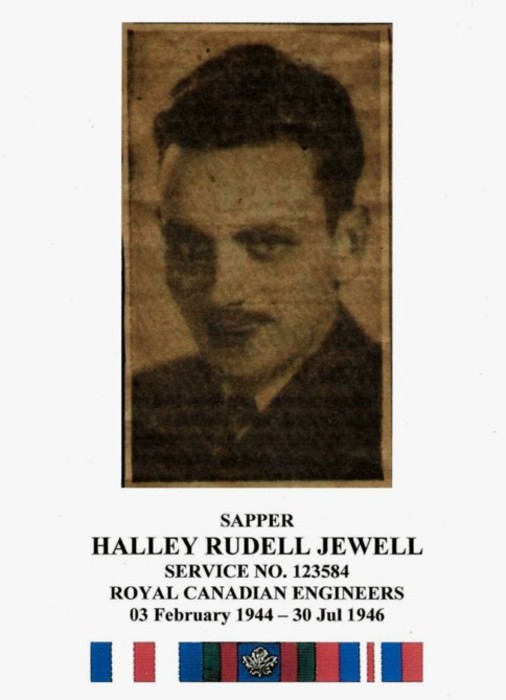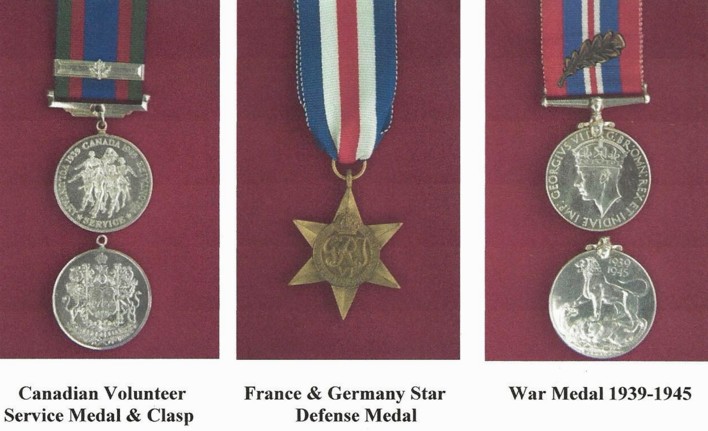
MILITARY HISTORY
Sapper Halley Rudell Jewell – No. 123584– Active Service (World War II)
On February 3rd, 1944, Halley Rudell Jewell completed the Attestation Paper for the Canadian Active Service Force (CASF) at Kingston, Ontario. He was 30 years old when, as a married man, he enlisted for the duration of the War. Halley was born in Lakefield, Ontario and gave his birthdate as 23rd April 1913. He listed his present address as 1013 Water Street, Peterborough, Ontario. He was married in 1936 and had two children. Halley indicated that he had no previous Military experience and he had not served in an Active Formation or Unit of The Canadian Army.
Halley indicated he had previously worked seven years at Canadian General Electric as a painter in the machine shop, previously as a painter’s helper with his father and as a sampler at a concrete plant from 1926 – 1933. He had left school in grade 9 having lost interest and wanting to work. He was described by the recruiting officer as above average intelligence and in good shape physically.
Halley was fully trained as a soldier in the Royal Canadian Expeditionary forces in British Columbia, qualified as a painter and decorator and transferred to the infantry (Royal Canadian Engineers) where he served 4 months as a mortarman and 4 months as a postal clerk.
His next-of-kin was listed as his wife, Mrs. D, Mae Jewell living in Lakefield, Ontario.
Sapper Jewell embarked overseas on July 11th, 1944 and was in active service in the Royal Canadian Engineers until 15th June 1946. During his service, Sapper Jewell was promoted to Lance Corporal on 2nd September 1944, reverted to Sapper on 12th September 1944, and left the UK for action in France and Germany on January 1, 1945.
During his active service Royal Canadian Engineers (RCE):
RCE troops travelled far and wide in the performance of their duty during the war installations. The RCE played an important part in the major campaigns which brought about the German defeat. Operations in Sicily and Italy posed special problems. As the Germans retreated through the mountainous terrain, they destroyed the few roads available to the pursuing Allies, as well as bridges over the interminable water barriers and stream beds. Many of the latter were empty in the dry summer months but strewn with large boulders which testified to the torrents unleashed during the rainy season. Facilitating mobile operations in such country proved to be an arduous task. The nature of this campaign provides an example of the vital job done by the RCE. A. J. Kerry and W. A. McDill’s. The History of the Corps of Royal Canadian Engineers, vol. II 1939-1946 describes “The important part enemy demolitions played in delaying the drive and . . . the opportunities the enemy sappers had to create trouble and confusion at every “twist and turn” in this mountainous country. When an advance is made against an enemy who chooses to stand and fight, the infantry have the predominant role. But in this . . . trek the load bore heavily on the engineers. It was emphasized again and again . . . that the division could go forward only as rapidly as craters could be filled, diversions or bridges built and the roads repaired (p. 157).”
The RCE continued to perform their “routine” chores throughout the campaign in Europe, but they also took on a variety of less publicized and less glamorous jobs. Among these were the production of smoke screens to hide combat movements, and construction of fuel pipelines in the sector of Northwest Europe held by First Canadian Army. Perhaps the most difficult tasks, however, were done by the sappers who cooperated with the Imperial War Graves Commission and the various Graves Concentration and Graves Registration Units to provide a final home for comrades who would not return to their families.
Sapper Jewell disembarked in the UK on 15th May 1946, and he returned to Canada on 16th June, 1946 on the “Ile de France”.

On July 30th, 1946, Halley was discharged from the Canadian Army to return home. He returned to civilian life (on demobilization) and was granted a Clothing Allowance of $100.00 and a Rehabilitation Grant at No. 3 District Depot, Kingston, Ontario.
Sapper Jewell applied for his War Service Gratuity (WSG). On August 13, 1946, his WSG was calculated as $910.00; this amount was paid to him in monthly instalments of $48.27.
According to Halley Jewell’s Military File he served a total of 29 months with the Canadian Active Service Force, five months in Canada and two years, overseas.
Halley’s Military File indicates that he was eligible to receive the following Medals:
Canadian Volunteer Service Medal & Clasp; France and Germany Star Defense Medal and the War Medal 1939-1945

PERSONAL HISTORY
HALLEY RUDELL JEWELL
Halley Rudell Jewell was born on April 23, 1913, the son of Mary Ellen “Ella” Bickell and Truman Rudell Jewell of Lakefield. Halley was born in the same red brick house on Lakefield Road at the intersection of Buckhorn Road south of Lakefield village as his mother while she was visiting her parents. Truman and Ella lived on the corner of Burnham and Charlotte Street with their three sons – Halley, Harry born in 1917 and Eldon born in 1921 until about 1924. Then they moved to Concession Street. Halley attended the Lakefield Public School along with his younger brothers. In his youth, Halley worked as a sampler at the concrete plant after school.
In his youth Halley belonged to a young people’s group for many years. He was very musical playing the piano and trombone taught to him by his Dad and was a member of the Lakefield Citizen’s Band. He loved to fish and hunt with his brothers. Halley left school and went to work with his Dad as a painter’s helper. Later he moved to Peterborough and went on to work at the Canadian General Electric as a spray painter for seven years. He met and married Mae Hatcher on September 27, 1936. They made their home on Water Street in Peterborough and had two children Eleanor and Donald.
Halley went to Kingston and enlisted to serve his King and Country on February 2, 1944. Upon his return from the war in July 1946 he returned to the Canadian General Electric and resumed his former job. Mae and Halley continued to live in Peterborough on Jackson Avenue and Halley was a member of the Royal Canadian Legion Branch #52. Sadly Mae passed away on March 17, 1974 and Halley died on April 15, 1974; both are buried in Highland Park Cemetery in Peterborough, ON.
FAMILY HISTORY OF HALLEY RUDELL JEWELL
The paternal grandparents of Halley Rudell Jewell were Sheldon Hawley Jewell and Hannah Victoria Godfrey. Sheldon was born in Adolphustown, Lennox & Addington County, Ontario on April 21, 1852 and Hannah was born in Lakefield on March 21, 1862. Sheldon and Hannah were married in Smith Township on September 15, 1880. Sheldon was a farmer and they had two children – Lilly Jane and Truman Rudell Jewell. Sadly Sheldon passed away on May 15, 1899 at the age of 47 and Hannah went to live with her daughter Lilly Rowe in Lakefield until she passed away on July 22, 1941; both are buried in Lakefield Cemetery.
The maternal grandparents of Halley Rudell Jewell were Richard Henry “Harry” Bickell and Christina Jane Wood. Harry was born on April 17, 1863 in Smith Township and Christina was born in Ashburnham, Peterborough on June 3, 1860. They married in Lakefield on June 9, 1885 and made their home in the red brick house on Lakefield Road south of the village where Harry farmed with his father. They had a family of seven children – John James “Bruce”, Mary Ellen, Roxy May, Gracie, Lillian, Mabel Agnes, and Christina Beatrice Bickell. Harry passed away on March 28, 1934 and Christina died on October 12, 1935; both are buried in Lakefield Cemetery.
The parents of Halley Rudell Jewell were Truman Rudell Jewell and Mary Ellen “Ella” Bickell. Truman was born in Lakefield on November 14, 1883 and Mary Ellen “Ella” Bickell was born in Smith Township on November 25, 1888. They were married in Smith Township on June 16, 1909 and made their home in Lakefield and raised three sons – Halley, Harry and Eldon Jewell. Truman was well-known in the Lakefield and area as an excellent painter and decorator. Sadly Truman passed away on November 10, 1959 and Ella died on January 3, 1975; both are buried in the Lakefield Cemetery.